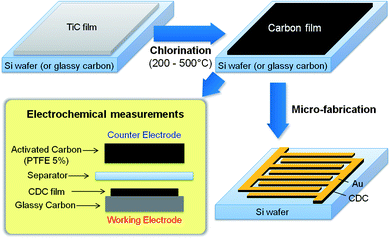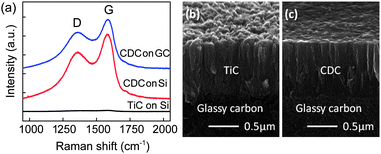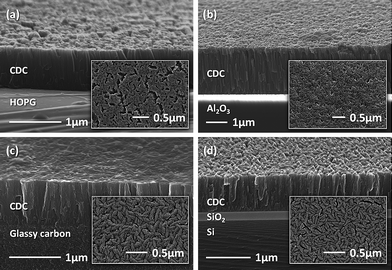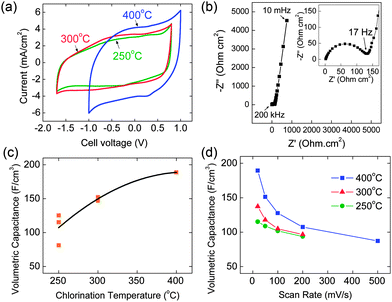Continuous carbide-derived carbon films with high volumetric capacitance
Min
Heon
a,
Samuel
Lofland
b,
James
Applegate
b,
Robert
Nolte
b,
Emma
Cortes
b,
Jeffrey D.
Hettinger
b,
Pierre-Louis
Taberna
c,
Patrice
Simon
c,
Peihua
Huang
cd,
Magali
Brunet
d and
Yury
Gogotsi
*a
aDepartment of Materials Science and Engineering, Drexel University, Philadelphia, PA, USA. E-mail: yg36@drexel.edu; Fax: +1-215-895-1934; Tel: +1-215-895-6446
bDepartment of Physics and Astronomy, Rowan University, Glassboro, NJ, USA. E-mail: hettinger@rowan.edu; Fax: +1-856-256-4478; Tel: +1-856-256-4397
cUniversité Paul Sabatier, Toulouse III, CIRIMAT UMR CNRS 5085, France. E-mail: simon@chimie.ups-tsle.fr; Fax: +33 5 61 55 61 63; Tel: +33 5 61 55 68 02
dCNRS, LAAS, Université de Toulouse, France. Web: E-mail: mbrunet@laas.fr; Fax: +33 5 61 33 62 08; Tel: +33 5 61 33 62 21
First published on 4th November 2010
Abstract
Monolithic porous carbon film has a great potential for integrated supercapacitors due to no polymer binder, reduced macropore volume, and good adhesion between current collector and active material. It is demonstrated that continuous carbide-derived carbon (CDC) films can be synthesized on various substrates by dry etching. CDC films show high volumetric capacitance of ∼180 F cm−3 in 1.5 M TEABF4/acetonitrile electrolyte.
Broader contextMicroscale electrical power sources which are able to provide enough energy and satisfy the peak power demand are required for active RFID tags which can reach tens or even hundreds of metres, MEMS devices of several microns in size designed for the medical and pharmaceutical purpose, and sensors working in wireless monitoring systems. While batteries have been considered as prime candidates for those applications, supercapacitors can potentially provide a higher power density, maintenance-free operation and a longer lifetime. However, porous activated carbon electrodes that are conventionally used in supercapacitors have failed to reach the volumetric and areal energy density in a small form factor required for power supplies for integrated circuits, microelectronic devices or sensors. However, supercapacitors are still attractive, because of fast charging/discharging, which can enable self-sustaining micro-modules when combined with energy-harvesting devices such as solar cell, piezoelectric or thermoelectric micro-generators. In this study, porous carbide-derived carbon films have been developed for micro-supercapacitor electrodes and showed an excellent volumetric capacitance above 180 F cm−3 in an organic electrolyte. Since the synthesis method makes use of processes compatible with electronic device fabrication, it can be implemented in manufacturing supercapacitors integrated with silicon chips. A moderate synthesis temperature (250–400 °C) allows the use of a variety of substrates. |
Materials and devices for microscale and on-chip power storage applications have received increased attention as the era of mobile electronics and communication devices has come and the demand for improved performance has followed. Especially for these applications, electrochemical capacitors or supercapacitors have great potential to play an important role, even when compared with other currently available electrical energy storage (battery) technologies in terms of power density and device reliability.1–7
The way semiconductor technologies have evolved shows that the integration of all components onto Si wafers would be the ultimate solution to most problems facing long term use of mobile electronic devices. In a similar way, integration of electrical energy storage devices with solar cells would be beneficial for storing energy more efficiently during peak hours. However, generally, porous carbon electrodes for micro-supercapacitors have been employing polymer binders. It was reported that powder-based carbon electrodes patterned on Si substrate by ink-jet techniques showed good performance as a micro-supercapacitor.8 The electrodes consisting of carbon powder mixed with a binder may not necessarily be the ideal solution for integrated micro-devices because of the thickness control, surface uniformity, and reliability issues that come from using particles on a chip. A great potential of monolithic porous carbon films for supercapacitors was recently demonstrated.7 Nanoporous carbide-derived carbon (CDC) films on titanium carbide (TiC) have shown very high volumetric capacitance and a potential for being integrated into electronic devices and solar batteries. Carbide-derived carbons have attracted much interest in the past because of their tunable pore size that enables applications in sorbents and electrochemical capacitors.9–11 A new concept for manufacturing supercapacitors, with the electrodes directly connected to the substrate, unlike conventional supercapacitor electrodes produced from carbon powders, was proposed by Chmiola et al.7 Elimination of polymer binders and macropores between the particles, and a naturally strong interface between the current collector and the active material led to a significant increase in the volumetric capacitance. However, synthesis of CDC on bulk TiC ceramics has limitations. Also, the uniformity and integrity of the films should be improved further. The continuous porous carbon film on the Si wafer is expected to take current electrochemical capacitor technologies to another level, enabling utilization of a variety of conventional microfabrication technologies.
The objective of this work was to produce uniform and adherent porous carbon films on various substrates by a process compatible with Si-based device fabrication processes and to demonstrate sufficiently high capacitance of those films.
Titanium carbide films were deposited by reactive DC magnetron sputtering with a Titanium target and acetylene (C2H2) gas as a carbon source.12 The Ti target is run at 200 W at an overall pressure of 30 mTorr. The gases were mixed in a manifold with an argon flow rate of 40 sccm and a C2H2 flow rate of 2.5 sccm.13,14 The substrate is heated to approx. 700 °C to produce textured TiC in the (111) orientation. The resulting deposition rate was approximately 25 nm min−1 on Si wafer (resistivity 1–100 Ohm cm with 200 nm wet thermal oxide), glassy carbon (SIGRADUR, G plate, one side diamond polished, Ra < 10 nm), Al2O3 ((0001) oriented epi-polished) and highly ordered pyrolytic graphite (HOPG, monochromator grade). The reactive-sputtered TiC films were etched by chlorine gas to form CDC films. TiC films on glassy carbon substrates or Si wafers were chlorinated in a horizontal tube furnace.15Argon purging was done for at least 24 hours before heating up to keep samples from oxidation during thermal treatment. Samples were heated to the temperature range from 250 °C to 500 °C in Argon atmosphere. Once the desired temperature was reached, chlorine gas passed through the 1 inch diameter quartz tube at the speed of 10–15 cm3 min−1 for 30 minutes. After chlorination, the furnace was cooled to room temperature under flowing argon.16Scanning electron microscopy (SEM) analysis was conducted using a Zeiss Supra VP-50 field emission scanning electron microscope to observe the surface morphology and measure the film thickness. Raman spectra of carbon film were acquired using a Renishaw RM 1000 Raman microspectrometer (1800 l per mm grating) with an Ar ion laser (514.5 nm, Spectra-Physics) in a backscattering geometry. The laser beam was focused with a 20× objective (spot size: approximately 5 µm).
Stainless steel tube fittings and rods were used to set up the electrochemical cell. Two 15 mm diameter stainless steel rods were put together with the carbon film on a glassy carbon substrate and activated carbon electrode in-between, separated by a PTFE separator (Scheme 1). 1.5 M tetraethylammonium tetrafluoroborate (TEABF4) in acetonitrile was used as an electrolyte. More than 20 mg of activated carbon electrode with 5 wt% of PTFE was used as the counter electrode, so that it could be regarded as a quasi-reference (constant-potential) electrode. Cyclic voltammetry, impedance spectroscopy and galvanostatic cycling were conducted using a Biologic VMP3 potentiostat on the 2-electrode cells prepared.
 | ||
| Scheme 1 Schematic of the sample preparation, electrochemical tests. | ||
One of the most common carbide materials, TiC, was chosen as a starting material for CDC films synthesis, because it has been well documented that carbon films produced from TiC can be used for supercapacitor electrodes.7,15 It can be deposited using chemical (CVD) and physical vapor deposition (PVD) techniques, but there has only been a single report on continuous CDC films produced from TiC films manufactured by magnetron sputtering.16 Therefore, we chose this method for making TiC films. TiC films can grow epitaxially in the (111) orientation at 700 °C on Al2O3 substrates.13,14 This technique also can produce TiC films on other substrates even if there is no epitaxial growth. Although the co-deposited films are smoother, reactive sputtering provides the options of significantly higher deposition rates and room temperature processing, both of which are important for device fabrication.
Titanium carbide films were deposited on Si wafers, glassy carbon, graphite, quartz and alumina substrates (Fig. 1 and 2). Wide range of TiC compositions were tried and since Ti-rich or carbon-rich films are not desirable to control the pore size, Ti![[thin space (1/6-em)]](https://www.rsc.org/images/entities/char_2009.gif) :
:![[thin space (1/6-em)]](https://www.rsc.org/images/entities/char_2009.gif) C ratio was kept between 40
C ratio was kept between 40![[thin space (1/6-em)]](https://www.rsc.org/images/entities/char_2009.gif) :
:![[thin space (1/6-em)]](https://www.rsc.org/images/entities/char_2009.gif) 60 and 50
60 and 50![[thin space (1/6-em)]](https://www.rsc.org/images/entities/char_2009.gif) :
:![[thin space (1/6-em)]](https://www.rsc.org/images/entities/char_2009.gif) 50, preferably close to 50
50, preferably close to 50![[thin space (1/6-em)]](https://www.rsc.org/images/entities/char_2009.gif) :
:![[thin space (1/6-em)]](https://www.rsc.org/images/entities/char_2009.gif) 50 to achieve higher crystallinity. Continuous porous carbon films were synthesized by chlorination at 250–500 °C following the reaction:
50 to achieve higher crystallinity. Continuous porous carbon films were synthesized by chlorination at 250–500 °C following the reaction:
| TiC + 2Cl2 → TiCl4 + C |
 | ||
| Fig. 1 Raman spectra of TiC film and CDC film on Si wafer, and CDC film on glassy carbon (a). Scanning electron micrographs of (b) TiC and (c) CDC film produced at 300 °C on glassy carbon. | ||
As shown in Fig. 2, carbon films were successfully produced on all substrates listed above. The primary factors considered in synthesizing porous carbon films are cracking and delamination of film. Thickness of initial TiC and chlorination temperature affects crack formation. It is mainly because removal of Ti atoms creates a tensile stress in the film, which increases with the film thickness during chlorination. Regarding substrates, besides graphite or HOPG, which is softer, cleaves easily and has a rougher surface compared to Al2O3, oxidized Si and polished glassy carbon, tendency to film cracking does not change much when changing substrates. Uniform porous carbon films up to around 3 µm in thickness can be synthesized on Si wafers by chlorination below 400 °C.
 | ||
| Fig. 2 Scanning electron micrographs of CDC films on highly ordered pyrolytic graphite (HOPG) produced at 500 °C (a), on Al2O3 produced at 400 °C (b), on glassy carbon produced at 300 °C (c), and oxidized Si wafer produced at 300 °C (d). | ||
TiC film deposited by reactive magnetron sputtering had a columnar structure (Fig. 1b) which may be one of the reasons why some cracks form in lateral direction in CDC film during dry etching process at elevated temperatures. However, grain-boundary cracks were in the 100 nm range and only appeared at chlorination temperatures of 400 °C and above (Fig. 2a), with the crack density and size increasing with the increasing temperature and film thickness.
Scanning electron micrographs clearly show that deposited TiC film on glassy carbon has uniform thickness of around 1µm, smooth surface and CDC films produced at temperatures between 250 and 350 °C inherited the TiC film morphology and had 0.8–1 µm thickness which is very close to the TiC thickness (Fig. 2). Through this transformation of carbide to carbon films it is well known that the general microstructure and surface morphology of the carbide film is retained after CDC formation.17
Precautions were taken when growing films on Si. When TiC is deposited on Si wafer without SiO2 and etched by chlorine, chlorine gas reacts not only with titanium atoms from TiC films but also with the Si wafer underneath at the same time, resulting in delamination of the carbon film from the substrate. Thermal oxide (SiO2) of about 200 nm in thickness was used to protect the Si wafers and to avoid delamination of carbon films (Fig. 2d). This protection was sufficient at temperatures up to 500 °C for up to 30 minutes.
The deposited TiC film only has weak carbon bands in Raman spectra (Fig. 1a) originating from traces of free carbon, however, the synthesized CDC film shows, regardless of substrate, the characteristic broad D- and G-bands of graphitic carbon at around 1350 cm−1 and 1580 cm−1, respectively, which indicates that TiC has been transformed to carbon having a disordered microstructure.16,18,19 This amorphous carbon structure results from the low synthesis temperature.15 These results show that carbon films can be produced from TiC at temperatures as low as 250 °C and complete chlorination of micrometre-thick films can be achieved in 30 minutes or less. This was also confirmed by energy-dispersive X-ray spectroscopy in an SEM. There was no residual Ti in the films, showing that lower synthesis temperatures than reported in the literature can be achieved.7,20 As shown in Fig. 1, the TiC film and CDC film on glassy carbon show the same surface morphology. Thus, we anticipate that CDC films on Si and other substrates will have the same capacitance as the films produced on the glassy carbon surface.
For the electrochemical measurements, highly conductive glassy carbon was used to make an electrochemical cell with an electrical contact directly to the substrate without adding a current collector or performing other operations that may affect capacitance of the carbon films or create contact impedance at the current collector/film interface. They were tested to characterize electrochemical properties by using a simple 2-electrode electrochemical cell configuration with an over-capacitive activated carbon used as the counter electrode, which has a much larger surface area than the carbon film on glassy carbon substrate (Scheme 1).
CDC films were tested in a 1.5 M solution of tetraethylammonium tetrafluoroborate (TEABF4) in acetonitrile (AN), which is the most common organic electrolyte. Cyclic voltammetry (CV) and electrochemical impedance spectroscopy (EIS) results in Fig. 3a and b indicate that CDC film shows an electrochemical capacitive behavior typical for a double layer capacitor. The sample produced at 400 °C showed volumetric capacitance above 180 F cm−3 at 20 mV s−1 scan rate, which is 3 times higher compared to conventional carbon electrodes (about 50 F cm−3 (ref. 21)) and almost identical to the data reported for CDC films on TiC.7 This shows that we have reached the goal of achieving the same excellent volumetric capacitance value on a film produced by sputtering on a non-carbide substrate. Furthermore, volumetric capacitance of CDC films decreases as the chlorination temperature decreases (Fig. 3c), which means that the average pore size of CDC film becomes closer to electrolyte's ion size. This is in agreement with the previous results regarding capacitive behavior of TiC-derived carbon powder showing a decrease of capacitance with temperature for CDC produced below 500–600 °C.20 It was shown that if the average pore size is too small for cations or anions to enter, then distortion on CV was observed, resulting in capacitance decrease.22 In Fig. 3a, it can be seen that at negative potentials, larger TEA ions have difficulties to enter small pores in CDC films. No distortion was observed for smaller BF4 ions, suggesting that the pores even at the lowest synthesis temperature were close to 0.6–0.7 nm.20 Still, the capacitance values are very high compared to the published data for any kind of powder EDLC electrode even at the lowest synthesis temperature. Thus, while some capacitance is compromised by going to temperatures below 400 °C, the decreased capacitance is still high enough for device applications and the lower synthesis temperature may decrease process cost and increase the range of substrates that can be used. The previous studies showed an increase in the volumetric capacitance with a decrease in the scan rate and we observed it for CDC films as well. Still, cycling at 500 mV s−1 could be performed for the films produced at 400 °C (Fig. 3d).
 | ||
| Fig. 3 Electrochemical characterization; (a) cyclic voltammetry of CDC films produced at 250, 300, and 400 °C, respectively, normalized by the volume of CDC films, (b) Nyquist impedance plot of CDC film produced at 300 °C, (c) volumetric capacitance vs.chlorination temperature, and (d) volumetric capacitance vs. scan rate. | ||
Excellent volumetric capacitance of CDC films, their good adhesion to various substrates and the synthesis temperatures in the 250–500 °C range suggest that CDC film supercapacitors can be used for applications in power sources for MEMS devices, intermediate storage for energy harvesting microsystems, and numerous sensors and sensor networks.
Conclusions
It has been demonstrated that continuous carbon films are able to be synthesized by dry etching of sputtered TiC films on glassy carbon, Si and other substrates. Carbon films show high volumetric capacitance of up to 180 F cm−3 at 20 mV s−1 scan rate in 1.5 M TEABF4/acetonitrile. Volumetric capacitance decreases as chlorination temperature decreases from 400 °C to 250 °C because as chlorination temperature decreases, the average pore size becomes smaller which constrains TEA cation adsorption/desorption in pores. Optimization of the film synthesis conditions is expected to enhance ion accessibility to pores by tailoring pore size, which would lead to further increase in capacitance and response rate, resulting in an increase in both energy and power density.Acknowledgements
The effort at Drexel University was supported in part by the US Department of Energy, Office of Basic Energy Sciences, Division of Materials Sciences and Engineering under award ER46473. The work at Rowan University was supported by the NSF under grant number DMR-0503711. Collaboration between the participating universities was supported by the Partnership University Fund (PUF).Notes and references
- B. E. Conway, Electrochemical Supercapacitors: Scientific Fundamentals and Technological Applications, Kluwer Academic/Plenum, New York, 1999 Search PubMed.
- R. Kötz and M. Carlen, Electrochim. Acta, 2000, 45, 2483–2498 CrossRef CAS.
- A. G. Pandolfo and A. F. Hollenkamp, J. Power Sources, 2006, 157, 11–27 CrossRef CAS.
- G. J. La O', H. J. In, E. Crumlin, G. Barbastathis and Y. Shao-Horn, Int. J. Energy Res., 2007, 31, 548–575 CrossRef.
- S. W. Lee, B.-S. Kim, S. Chen, Y. Shao-Horn and P. T. Hammond, J. Am. Chem. Soc., 2008, 131, 671–679.
- M. Kaempgen, C. K. Chan, J. Ma, Y. Cui and G. Gruner, Nano Lett., 2009, 9, 1872–1876 CrossRef CAS.
- J. Chmiola, C. Largeot, P.-L. Taberna, P. Simon and Y. Gogotsi, Science, 2010, 328, 480–483 CrossRef CAS.
- D. Pech, M. Brunet, P. L. Taberna, P. Simon, N. Fabre, F. Mesnilgrente, V. Conedera and H. Durou, J. Power Sources, 2010, 195, 1266–1269 CrossRef CAS.
- N. F. Fedorov and V. V. Samonin, Russ. J. Appl. Chem., 1998, 71, 600–603.
- S. K. Gordeev and A. V. Vartanova, Zh. Prikl. Khim., 1994, 67, 1080–1084 CAS.
- Y. Korenblit, M. Rose, E. Kockrick, L. Borchardt, A. Kvit, S. Kaskel and G. Yushin, ACS Nano, 2010, 4, 1337–1344 CrossRef CAS.
- T. Zehnder and J. Patscheider, Surf. Coat. Technol., 2000, 133–134, 138–144 CrossRef CAS.
- W. D. Sproul, J. Vac. Sci. Technol., A, 1986, 4, 2874–2878 CrossRef CAS.
- J. E. Sundgren, B. O. Johansson, S. E. Karlsson and H. T. G. Hentzell, Thin Solid Films, 1983, 105, 367–384 CrossRef CAS.
- R. Dash, J. Chmiola, G. Yushin, Y. Gogotsi, G. Laudisio, J. Singer, J. Fischer and S. Kucheyev, Carbon, 2006, 44, 2489–2497 CrossRef CAS.
- E. N. Hoffman, G. Yushin, B. G. Wendler, M. W. Barsoum and Y. Gogotsi, Mater. Chem. Phys., 2008, 112, 587–591 CrossRef CAS.
- Z. G. Cambaz, G. N. Yushin, Y. Gogotsi, K. L. Vyshnyakova and L. N. Pereselentseva, J. Am. Ceram. Soc., 2006, 89, 509–514 CrossRef CAS.
- S. Urbonaite, L. Halldahl and G. Svensson, Carbon, 2008, 46, 1942–1947 CrossRef CAS.
- A. C. Ferrari and J. Robertson, Philos. Trans. R. Soc. London, Ser. A, 2004, 362, 2477–2512 CrossRef CAS.
- J. Chmiola, C. Largeot, P.-L. Taberna, P. Simon and Y. Gogotsi, Angew. Chem., Int. Ed., 2008, 47, 3392–3395 CrossRef CAS.
- J. Chmiola, G. Yushin, Y. Gogotsi, C. Portet, P. Simon and P. L. Taberna, Science, 2006, 313, 1760–1763 CrossRef CAS.
- R. Lin, P. L. Taberna, J. Chmiola, D. Guay, Y. Gogotsi and P. Simon, J. Electrochem. Soc., 2009, 156, A7–A12 CrossRef CAS.
| This journal is © The Royal Society of Chemistry 2011 |
